


Get ready to be captivated and maybe just a tad unsettled as we reveal the most mind-blowing and jaw-dropping nature photos out there. We've handpicked a collection that will leave you in awe, accompanied by spine-tingling stories and mind-boggling facts. These pictures capture the pure and diverse beauty of the natural world, and some might make you question if they're even real.
While a few might be a bit tough to look at, we encourage you to read the descriptions to fully grasp how amazing they are. Go ahead and show these to your pals to leave them utterly astonished, but most importantly, savor the breathtaking beauty of nature frozen in these stunning snapshots.

Behold, the baby alligator, a living relic that harkens back to the age of dinosaurs. These remarkable creatures boast lifespans of up to two centuries and can tip the scales at a staggering 200 pounds. Yet, they pale in comparison to the largest alligator snapping turtle ever recorded, a colossal 249-pounder residing in Chicago's Shedd Aquarium. Legend has it that during the Great Depression, a colossal 403-pound behemoth surfaced in Kansas, though its existence remains shrouded in mystery.
These ancient reptiles have witnessed the ebb and flow of time, surviving for generations with their sturdy shells and powerful jaws. Their existence speaks volumes about nature's enduring wonders and the mysteries that still lie hidden beneath the surface of our world's rivers and swamps.

The hairless chimp, with its bare and exposed skin, offers a rare glimpse into the inner workings of these magnificent animals. Chimpanzees are known for their remarkable intelligence, complex social structures, and incredible physical strength, and when stripped of their fur, we get to witness the intricate network of muscles that enable them to swing from trees, navigate through dense forests, and even engage in fierce territorial battles. This unique condition, alopecia, gives us a newfound appreciation for the resilience and adaptability of chimpanzees.
Research indicating that chimpanzees can possess such extraordinary strength compared to humans underscores the fascinating world of primates. Pound for pound, they are true powerhouses in the animal kingdom. This revelation not only deepens our understanding of chimpanzees but also highlights the importance of conserving their habitats and protecting these incredible creatures.

Step back to 1989, off the windswept west coast of Northern France, where photographer Jean Guichard froze time in a single, awe-inspiring frame. In this incredible snapshot, a monstrous wave, like a titanic leviathan, appears poised to engulf a stoic lighthouse. And there, against all odds, stands a lone figure, a guardian of the beacon, defying the furious sea's voracious appetite.
This heart-pounding moment was orchestrated by Mother Nature herself, as a tempestuous low-pressure system from Ireland whipped up gale-force winds and monstrous waves, reaching a towering 20 to 30 meters in height. Guichard's lens captured the perfect storm, etching a scene of breathtaking beauty and unyielding human resolve into photographic history.
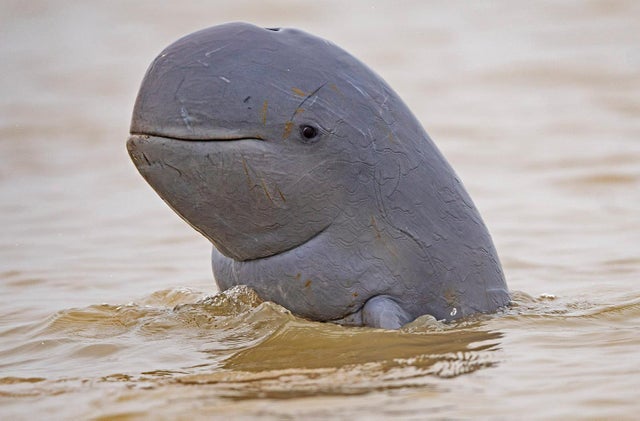
Enter the enigmatic world of the Irrawaddy Dolphin, a rare gem of the aquatic realm, with a perilously dwindling population of just 92 individuals. These mysterious creatures are instantly recognizable by their distinct features: a domed forehead, a truncated beak, and a remarkable array of 12 to 19 teeth per side in both jaws.
What sets them apart further is their unique lifestyle—transitioning effortlessly between the realms of saltwater and freshwater. Despite their portly appearance, these dolphins can tip the scales at a formidable 400 pounds (181 kg) and stretch to impressive lengths of up to 8 feet (2.4 meters). Surprisingly, for their size, they're considered slow swimmers, adding to the allure of these gentle giants as they navigate the murky waters of their diminishing habitat.

In the frozen moment of this mesmerizing photograph, nature's electrifying wrath is laid bare. A mighty tree, seemingly scarred by the very gods, reveals the aftermath of a lightning strike. What's truly astonishing is the tree's eerie transformation, as it smolders from the inside, resembling a silent inferno. This spectacle, although seemingly otherworldly, is not as rare as you might think.
Hidden within hollow trees, a sinister secret lies: they serve as nature's chimneys, accelerating the fire's consuming dance from within while leaving behind a deceptive facade of innocence. This photograph is a haunting reminder of the potent forces that shape our natural world, concealed within the heart of seemingly ordinary landscapes.
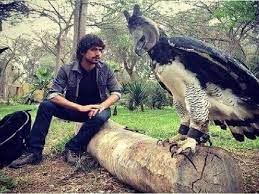
Meet the harpy eagle, a magnificent predator that rules the Amazon skies. These majestic birds have huge wings, stretching up to an astonishing six and a half feet, making them the kings of the bird world. They roam the lush lands of South America, and they're the top predators, making other rainforest creatures shiver in their feathers. They feast on monkeys, sloths, and even deer, proving their dominance in the Amazon's intricate web of life. In the heart of the Amazon, the harpy eagle symbolizes the wild and untamed side of nature.
These eagles are perfectly built for the rainforest. Their enormous wings help them glide through the thick jungle, and their sharp hunting skills ensure they catch their prey. Their existence reminds us of how vital it is to protect this incredible ecosystem and all the unique animals that call it home.
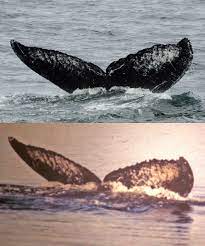
Experience the incredible journey of a humpback whale's tail, captured through photos from 1985 and 2020. These enormous ocean giants can live up to 80 to 90 years, showcasing incredible endurance.
Measuring up to 60 feet long and weighing a massive 80,000 pounds, they eat an astonishing 3,000 pounds of food every day. These amazing creatures swim through the deep waters, and their tails show the passage of time as they continue to be a part of our planet's oceans, a symbol of nature's greatness.
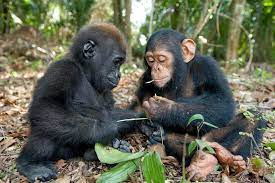
In the enchanting realm of wildlife, photographer Michael Poliza unveiled a captivating snapshot: a young gorilla and a chimp at play, a scene teeming with intrigue. Yet, the fate of their friendship as they mature remains a tantalizing enigma. The outcome could pivot on the specific gorilla species involved, with some notorious for their territorial and combative tendencies.
These giants of the jungle, eastern gorillas, hold the mantle as Earth's largest living primates, bearing a colossal frame. Picture a full-grown male, tipping the scales at 140 to 205.5 kilograms (309 to 453 pounds), and standing tall at 1.7 meters (5.6 feet) upright. As they navigate the labyrinth of life, their evolving bond keeps us spellbound by the wonders and complexities of the animal kingdom.
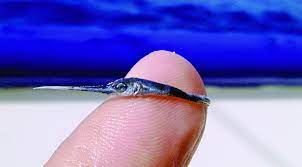
Behold the minuscule marvel known as the baby swordfish, a creature that defies belief as it hides its potential for colossal growth within its diminutive form. From this pint-sized wonder, a behemoth can emerge, reaching a staggering weight of over 1,000 pounds. These majestic billfish, including sailfish, sawfish, swordfish, and marlin, dance in the ocean's depths, each species harboring its unique enchantment.
In the realm of marlins, legends loom large. The record holder, snared on rod and reel, tipped the scales at a jaw-dropping 1,560 pounds, stretching a mammoth 14 feet and 6 inches in length. Yet, whispers circulate of a colossal catch off Venezuela's coast in 1976—a marlin so immense that it had to be cleaved into three parts for weighing, reportedly scaling a mind-boggling 4,500 pounds. Today, a replica stands sentinel at the Cultural Pavilion of the Republic, an enduring testament to the sea's boundless mysteries and the astonishing tales it weaves.
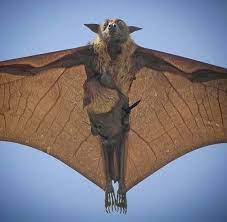
In the fascinating world of flying foxes, we find a baby Indian flying fox clinging tightly to its mother's belly, showing how much they depend on her. These little furry creatures stay close to the ground and can't fly on their own for several months. There are more than 60 species of flying foxes that fly across Asia, Australia, Africa, and various islands in the Pacific.
Among them, some have incredibly large wings, with a span of up to 5.25 feet. They feed on plants and glide gracefully through the air, but unlike some bats, they don't use echolocation to navigate. When they get older, they mate while hanging upside down, forming strong bonds in colonies that can be as large as 200,000, showing how these mysterious creatures come together.

Within the intriguing realm of nature, melanism emerges as a captivating phenomenon, adorning select animals with a striking darkness born of heightened melanin. Among its rarest manifestations, we discover the enigmatic melanistic alligators, a spectral rarity of fewer than 20 documented individuals on the planet.
These obsidian enigmas dwell in the shadowy waters, their form a testament to the allure of nature's secrets. In a delicate counterpoint, albinism bestows its ethereal touch upon fewer than 300 known albino alligators, a luminous manifestation of nature's diversity. Amidst the grand tapestry of life, these enigmatic beings stand as living enigmas, testaments to the enigmatic allure of our natural world.
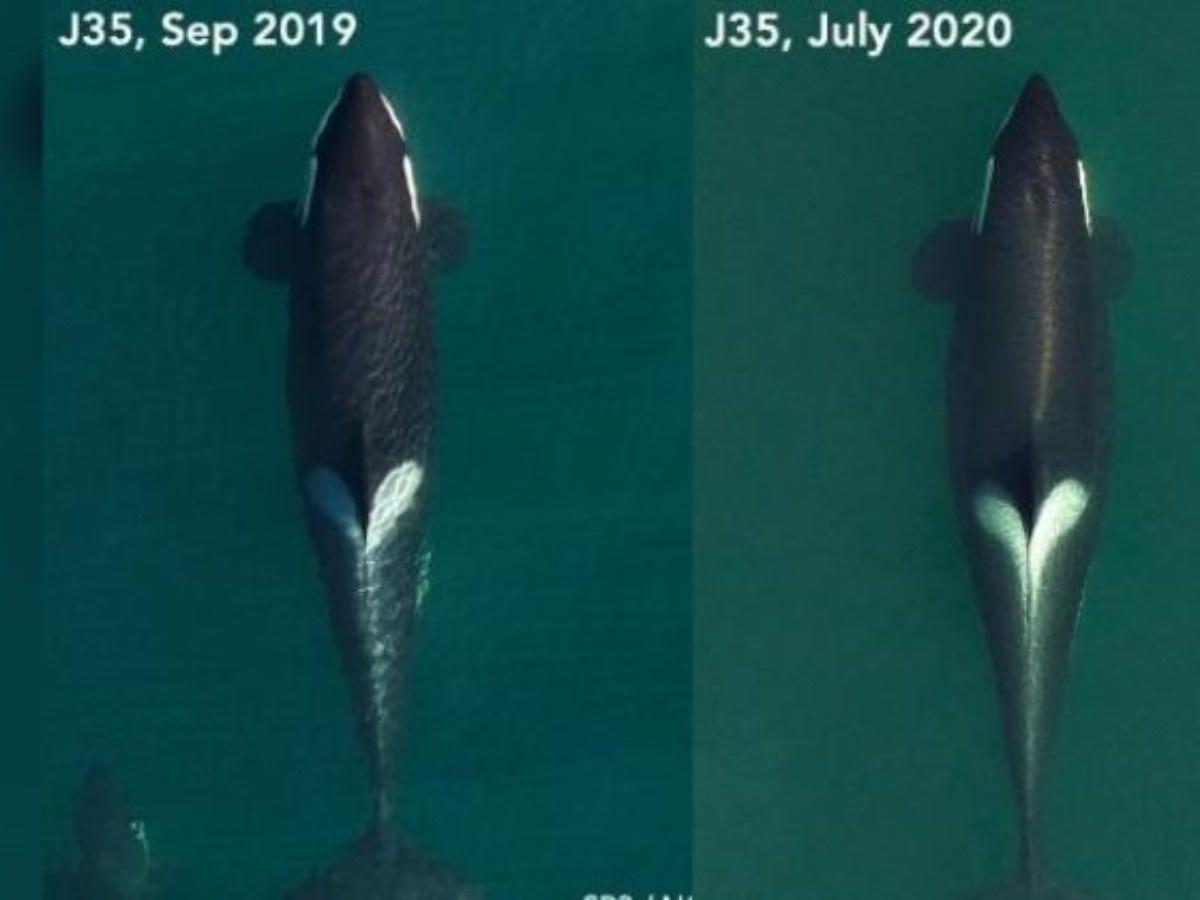
Meet the incredible whale who became famous in the world of marine life. Her story started sadly when she lost her baby whale. She held onto her baby for 17 days and traveled more than 1,000 miles, which was very heartbreaking. But from this tragedy, she became a symbol of a mother's strength. A year later, she was seen again in the ocean, showing that nature keeps going, even after sad times.
This whale's story touched the hearts of many because it showed how strong and emotional animals can be. Her return to the ocean after a difficult time gave us hope and reminded us that nature has a way of healing and moving forward, no matter what happens.
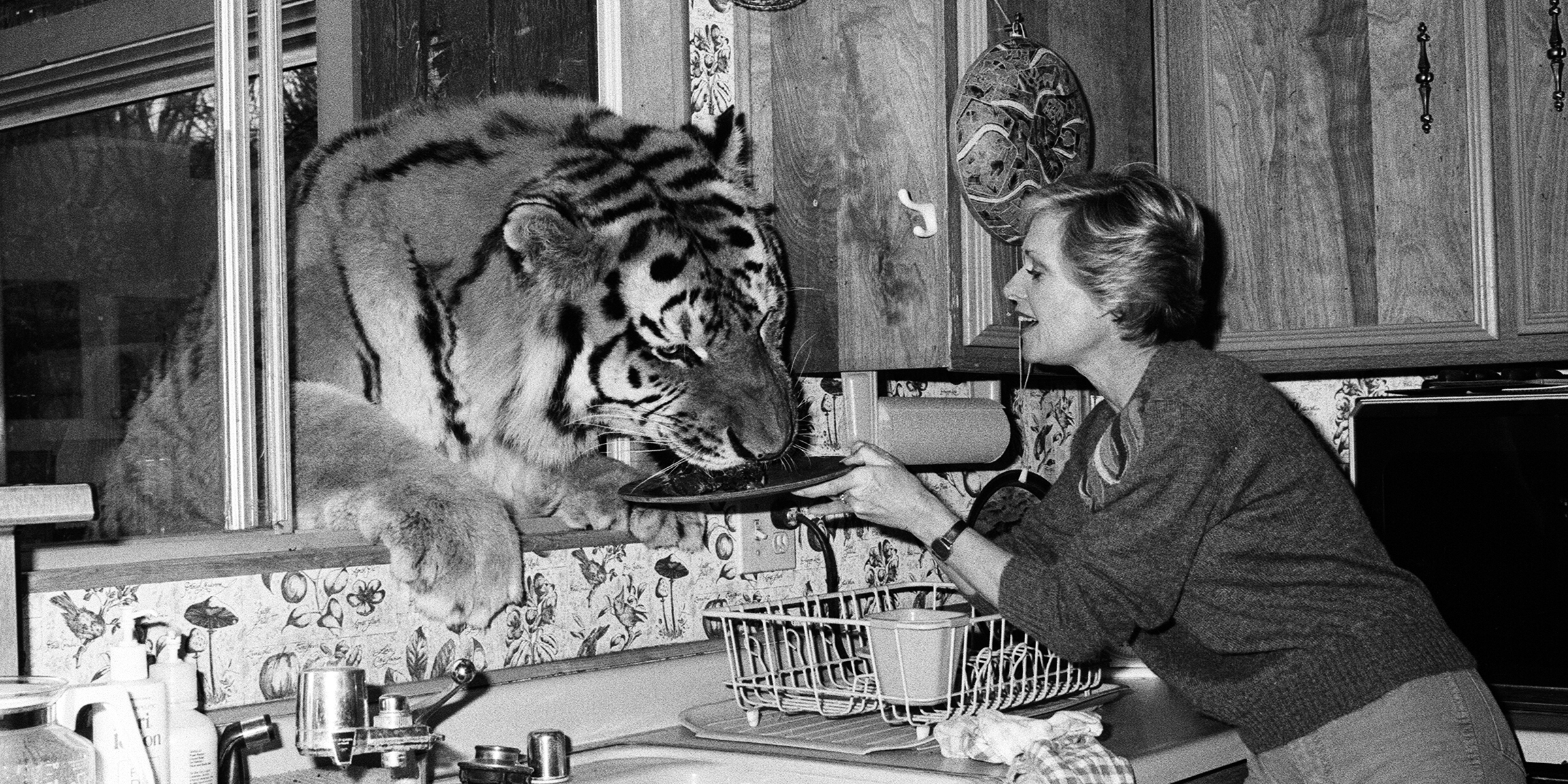
Behind Hollywood star Dakota Johnson's fame, there's a special family story. Her grandmother is an amazing woman who has a unique connection with tigers. In the past, her sanctuary was home to around 60 lions and tigers, showing her deep love for these animals. Even now, at 91 years old, she lives with about 13 or 14 of these incredible cats. This special bond between humans and animals goes beyond the glitz and glamour of Hollywood.
Her sanctuary is a place of hope for these big cats. Many of them were rescued as babies from circuses and other tough situations. With her care, they've grown and thrived. Their roars show the strong bonds of trust and friendship they share with her.
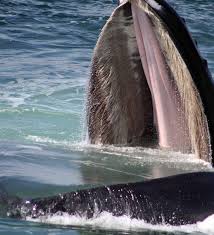
The baleen plates of humpback whales are nature's remarkable adaptation, perfectly suited to their culinary needs. These hair-like structures, made of keratin, form a flexible sieve that allows water to pass through while trapping their delectable prey. Humpbacks exhibit astonishing precision in their feeding technique; they open their colossal mouths wide, engulfing a colossal volume of water along with their unsuspecting prey. Then, with a powerful closing of their mouths and the aid of their tongue, they expel the water, leaving behind a feast of krill and small fish.
By regulating the populations of krill and small fish, humpback whales play a critical role in maintaining the delicate balance of the ocean food web. As they continue to roam the vast expanses of the sea, the humpbacks' dining spectacle remains an awe-inspiring testament to the wonders of the natural world, where innovation and adaptation have allowed these majestic creatures to thrive in their watery realm.
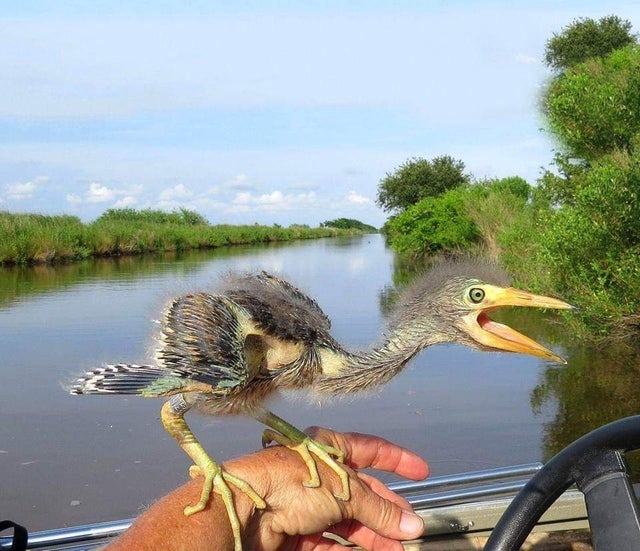
Embark on a journey through the corridors of time, where the age-old mystery of the dinosaurs finds its remarkable answer. Behold the birds, exquisite avian wonders that arose from the ashes of the past. Their ancestral lineage traces back to theropods, the very meat-eating dinosaurs that included the formidable Tyrannosaurus rex.
It's a breathtaking revelation, connecting the dots of evolution across millennia. The oldest bird fossils, a staggering 150 million years old, offer a window into the past, where these feathered pioneers embarked on a transformative journey that ultimately led to the diverse and captivating world of birds we know today.

Witness the gravity-defying marvels of nature as these goats take on the seemingly insurmountable. With an uncanny ability to conquer vertiginous heights, these agile climbers challenge the very limits of possibility. Their secret lies in the ingenious design of their hooves, split into two sections, akin to nature's own climbing apparatus.
In their daring ascent, they wield these split hooves to spread and grip vast surfaces, defying gravity's pull. The pièce de résistance? Rubber-like pads beneath, akin to the soles of shoes, bestowing them with an otherworldly grip that turns precipitous cliffs into playgrounds. Nature's acrobats, these goats perform a breathtaking ballet, leaving us in awe of the artistry of evolution.

Behold a mesmerizing snapshot of nature's raw drama, a rare glimpse into the world of survival captured by the talented Chinese photographer, Yongqing Bao. This moment, frozen in time, earned him the prestigious Wildlife Photographer of the Year award from London's National History Museum in 2019.
In this electrifying image, the very essence of terror dances in the eyes of a marmot, a heartbeat away from an encounter with a Tibetan fox, its eternal foe. It's a gripping tableau, where the forces of life and death collide, a masterpiece of the wilderness that leaves us spellbound, a testament to the timeless artistry of nature's theater.
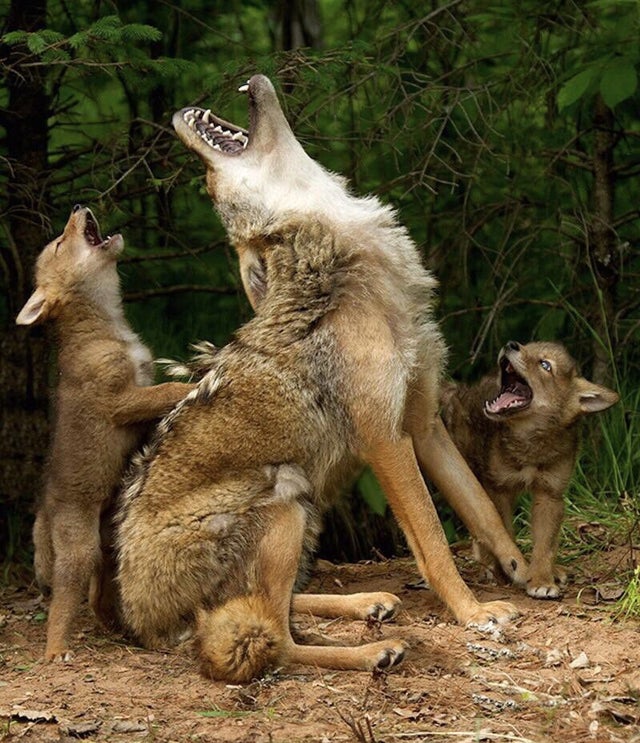
In the heart of the wild, a moment of profound connection unfolds before our eyes. The lens captures a mother wolf in an intimate exchange with her young cubs, imparting the timeless art of howling. In the language of wolves, the howl is more than a mere sound; it's a symphony of communication that resonates across the vast expanse of the wilderness.
These vocal harmonies forge bonds within the pack and can serve as a lifeline for a lost soul, guiding it home through the inky night. Remarkably, a wolf's howl is a siren song that echoes for 6-7 miles, a haunting melody that weaves through the tapestry of the untamed, evoking the very essence of the wild.
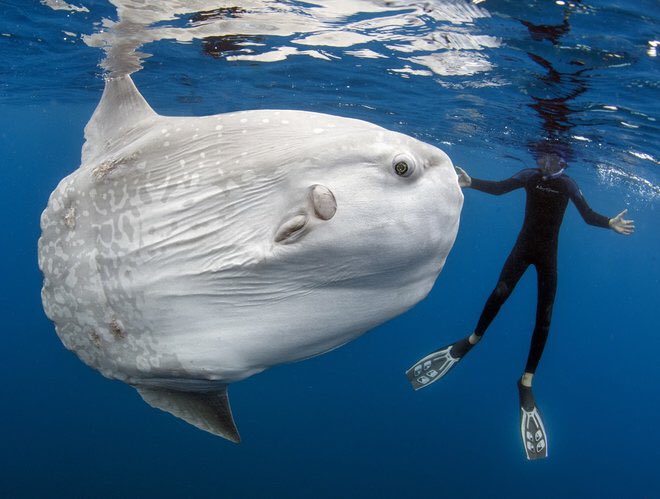
Delve into the depths of the ocean's mysteries and encounter the colossal marvel known as the Ocean Sunfish, or Mola Mola. These aquatic behemoths tip the scales at a staggering 540 to 2,205 pounds (247-1000 kg) and stretch their imposing frames up to 5.9 feet in length. In the realm of bony fish, they reign as titans, unrivaled in their weighty splendor.
Thriving in the embrace of temperate and tropical waters, they navigate the expanses between the Atlantic and Pacific Oceans, leaving an indelible mark as one of the sea's most enigmatic and massive inhabitants. Dive into the world of the Mola Mola and unravel the secrets of the deep.
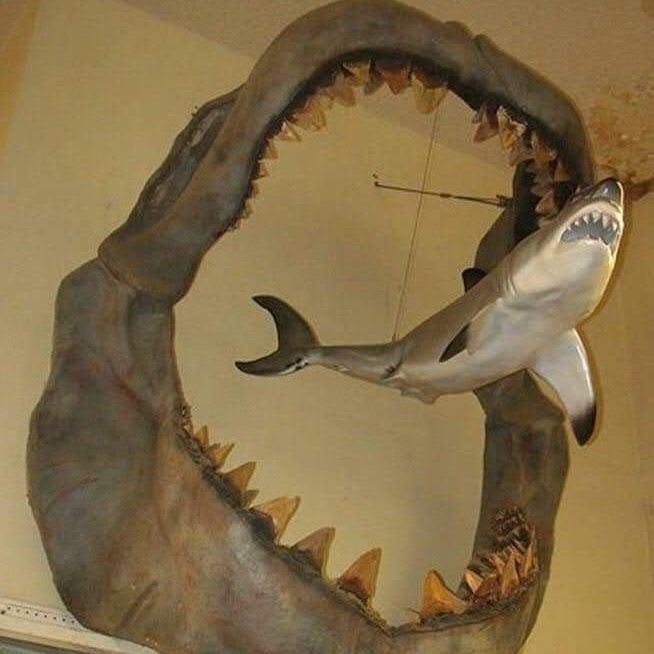
Step into the abyss of prehistoric oceans and grapple with the mind-bending enormity of ancient megalodons. This captivating photo unfurls a stark comparison between the colossal megalodon and its modern-day counterpart, the great white shark. These leviathans of yore are believed to have stretched their massive bodies to a jaw-dropping 60 feet in length, bearing a titanic weight that exceeded 40,000 pounds.
In the annals of Earth's history, scientists boldly declare the megalodon as the unrivaled apex predator, a gargantuan testament to the awe-inspiring grandeur of nature's past, where giants once ruled the depths of ancient seas with unparalleled majesty.
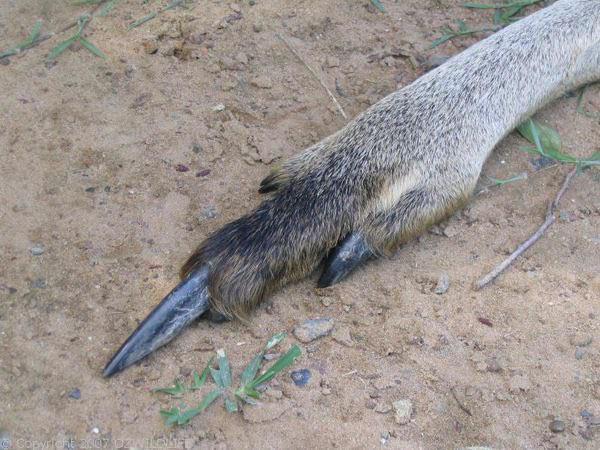
Behold the remarkable marvel concealed within a kangaroo's mighty hind leg—a testament to nature's ingenuity. In this anatomical spectacle, you'll discover a foot adorned with four or five toes, where the first, albeit minuscule, takes its place, while the second and third toes meld into a dynamic duo. Yet, beneath this seemingly unassuming appendage lies an astonishing secret—the bone-crushing, earth-shaking force it conceals.
With a kick that wields an awe-inspiring might, kangaroos unleash over 800 Pounds-of-force Per Square-inch (PSI), a formidable testament to their place as nature's pugnacious powerhouses, where every step resonates with the indomitable spirit of the wild.
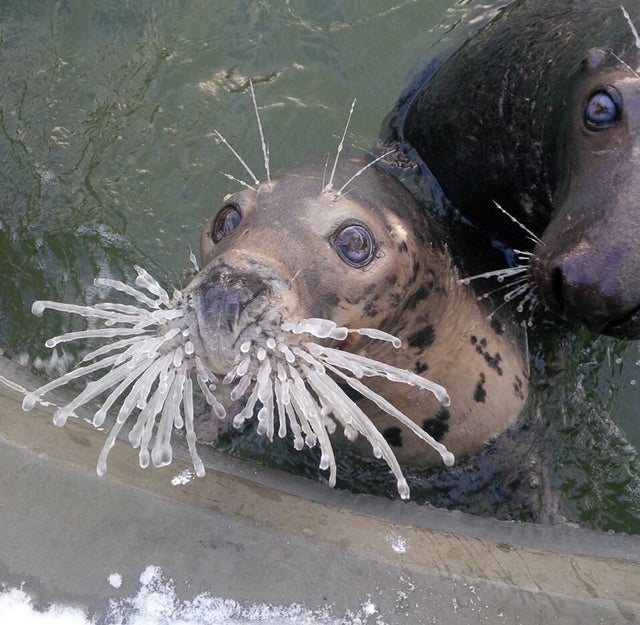
Dive into the intriguing world of whiskers, where the remarkable seal takes center stage with an astonishing revelation. While creatures like cats and rats possess a respectable 200 nerve endings in each whisker, the seal emerges as a sensory virtuoso, boasting an astounding 1,500 nerve endings.
These tactile marvels bestow upon seals an extraordinary ability—the power to navigate and seize their slippery prey, even in the absence of sight. Armed with this uncanny sensory arsenal, scientists assert that seals can discern and size up a herring down to the very centimeter, painting a vivid portrait of nature's ingenious adaptations in the theater of survival beneath the waves.
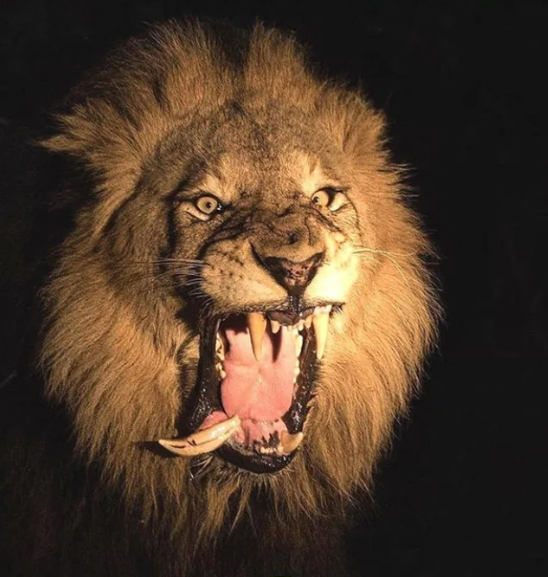
Behold the fearless lion, bearing the battle scars of a monumental encounter with a towering giraffe. This jaw-dropping image captures the aftermath of a mighty giraffe kick, which, astonishingly, can unleash an impact of 2,000 Pounds-of-force Per Square-inch (PSI). In the heart of the animal kingdom's arena, giraffes wield their awe-inspiring power, capable of delivering devastating kicks in any direction.
Such is their formidable prowess that these gentle giants have earned a fearsome reputation for dispatching even the noble lion with a single, lethal strike. It vividly showcases the unrelenting ferocity and immeasurable might that reverberate through the wilds of nature.
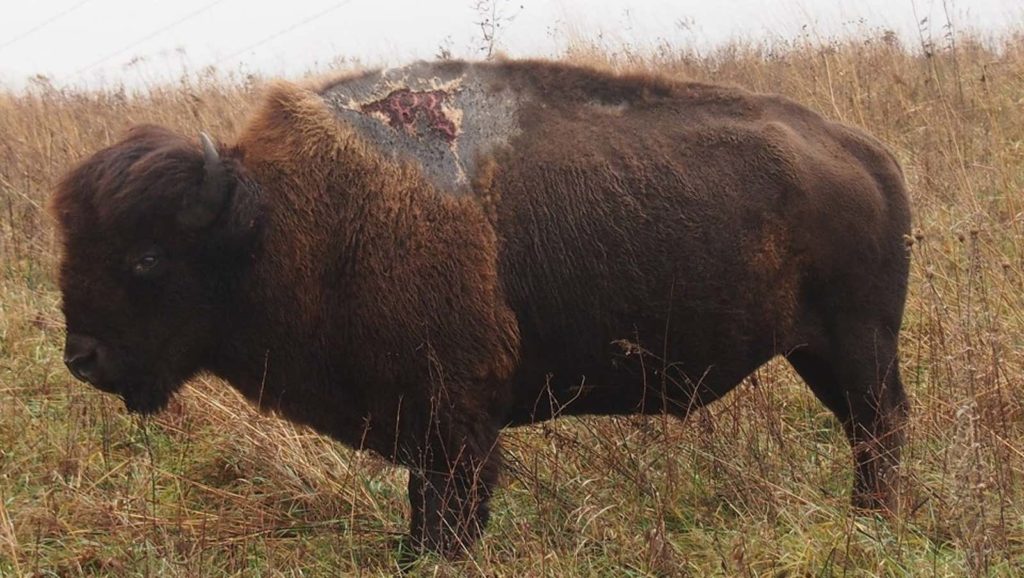
Meet Sparky, the bison with an electrifying tale of survival that ignited hearts across the land. In the fateful year of 2013, lightning struck, and this resolute bison bore the scars as a living testament to nature's indomitable spirit. Dubbed Sparky, he emerged as a symbol of the enduring strength of his species, an embodiment of resilience in the face of adversity.
With undaunted determination, Sparky embarked on a life well-lived, traversing the boundless prairies of Iowa's Neal Smith National Wildlife Refuge. Before the strike, he had already left a legacy, fathering three calves, a testament to the enduring legacy of a true survivor.
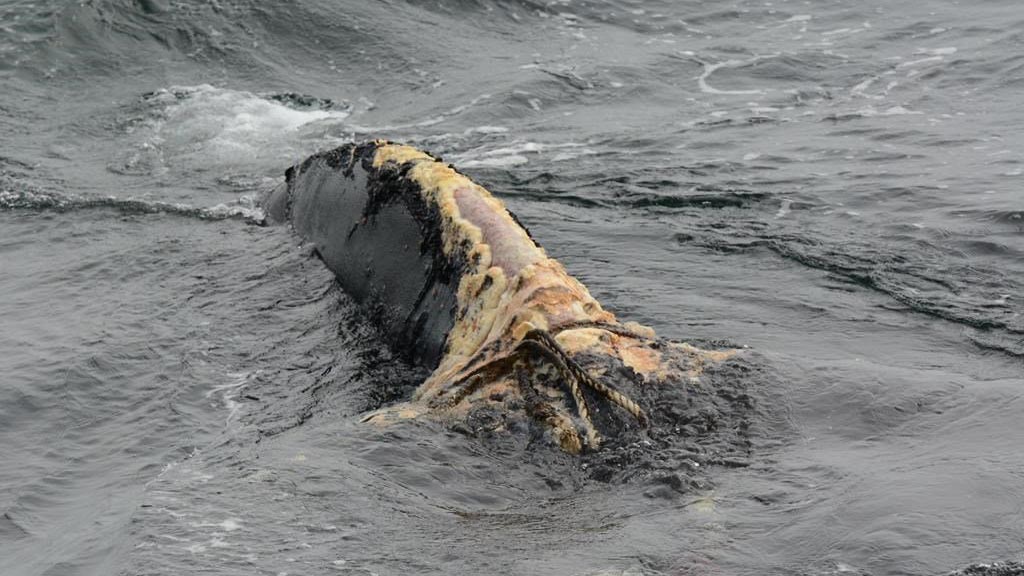
In the mysterious depths of the Gulf of St. Lawrence, a poignant drama unfolds as the Department of Fisheries and Oceans unveils a troubling sight—a North Atlantic right whale ensnared in the unforgiving grasp of fishing gear. This gripping observation materialized near the enchanting Magdalen Islands, a remote and challenging stage for this critical rescue mission, located some 56 miles northwest of the Etang du Nord port.
As the agency contemplates a tapestry of disentanglement strategies, the clock ticks in a race against time, a poignant reminder of humanity's delicate dance with these majestic creatures in the heart of the vast, unpredictable ocean.
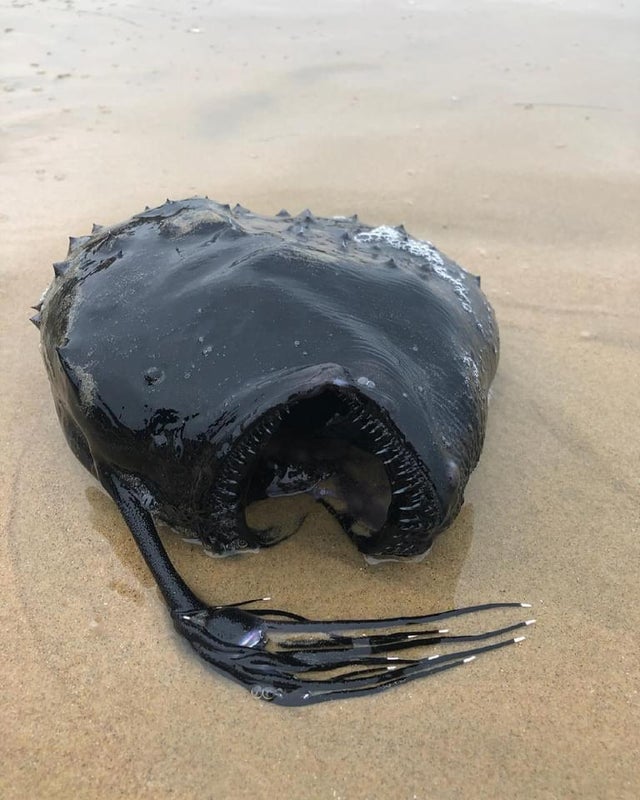
Prepare to be astonished by the ocean's enigmatic secret unveiled on the sun-kissed shores of Crystal Cove State Park in California—an anglerfish, a creature so elusive that it rarely ventures beyond the abyssal depths of the deep ocean. These mysterious denizens of the sea typically haunt the eerie twilight zone, lurking at unfathomable depths of around 3,000 feet. Their hallmark feature?
A remarkable, modified dorsal fin known as the esca, a living beacon of bioluminescence that lures unsuspecting prey into their clutches, only to be ensnared by the anglerfish's razor-sharp teeth. Yet, in nature's twisted irony, the esca's radiant allure can transform the hunter into the hunted, a testament to the relentless cycles of life in the hidden realms of the deep.
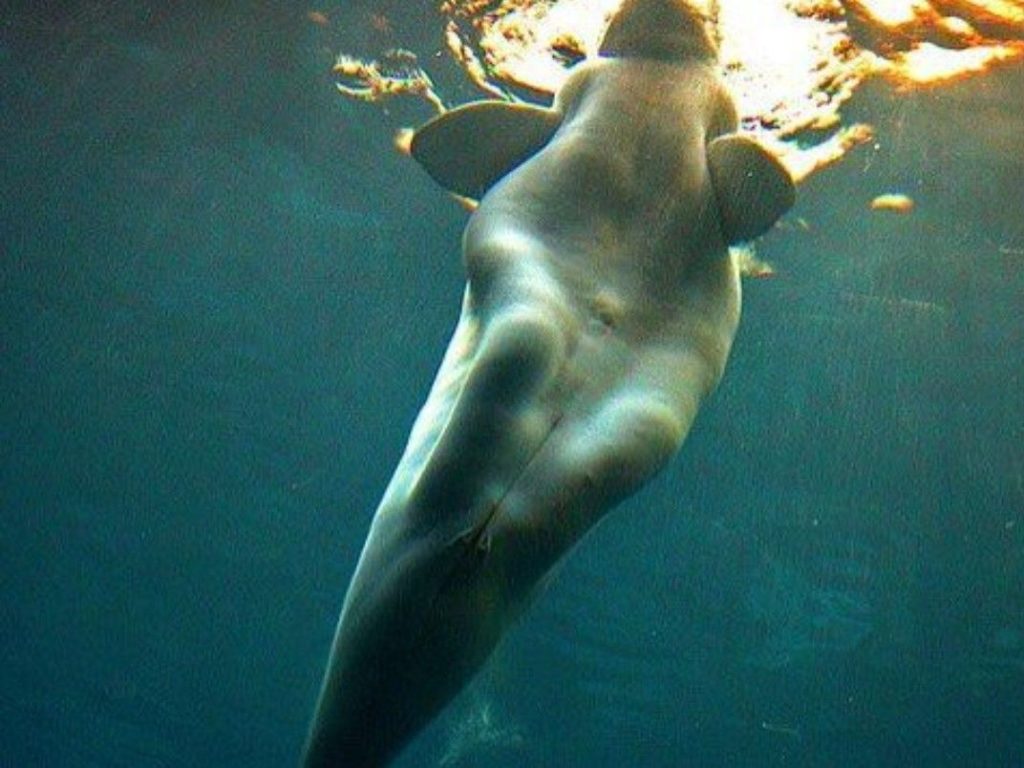
Behold the enigma of the Arctic depths—the beluga whale with its perplexing semblance of legs that has set the internet abuzz. Yet, beneath this viral spectacle lies a fascinating revelation. These seemingly bone-like, symmetrical structures are no mere whimsy of nature but a strategic adaptation to the frigid embrace of the Arctic and sub-Arctic waters they call home.
In truth, it's blubber, a wondrous manifestation of evolutionary brilliance—long "rails" of extra fatty insulation, snugly stored on their sides. Nature's ingenious answer to the icy chill, a testament to the beluga's resilience in the face of Arctic's unforgiving embrace, where survival thrives in the details of adaptation.
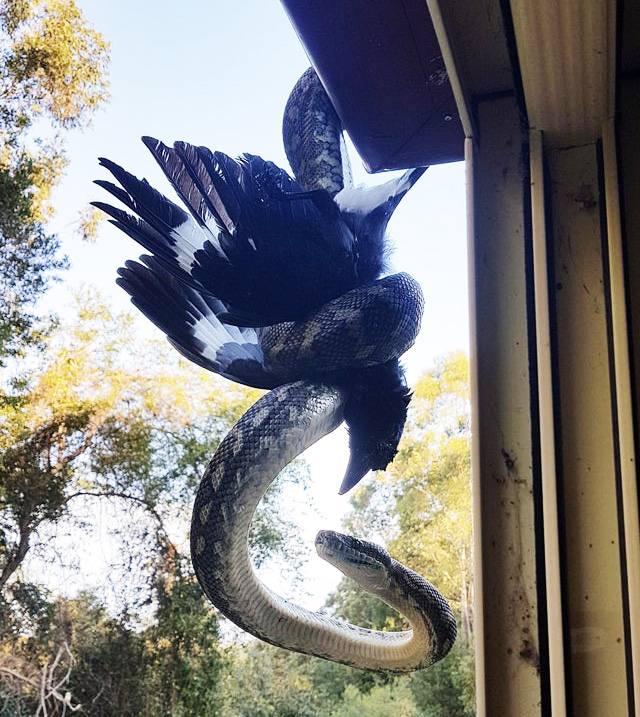
In the realm of online mysteries, an intrepid internet sleuth uncovered a feathered enigma perched upon their roof. While the debate rages on, some proclaim it to be a magpie, yet closer inspection unveils the true identity—a currawong, nature's stealthy trickster. Distinguished by its solitary, elegantly curved beak, the currawong emerges as the rightful denizen of eastern Australia.
Unlike its magpie counterpart with its sharp beak and contrasting hues, this avian sentinel's singular-colored beak and graceful curve serve as an emblem of its native heritage, a testament to the captivating diversity of Australia's winged wonders gracing both the skies and the digital frontier.
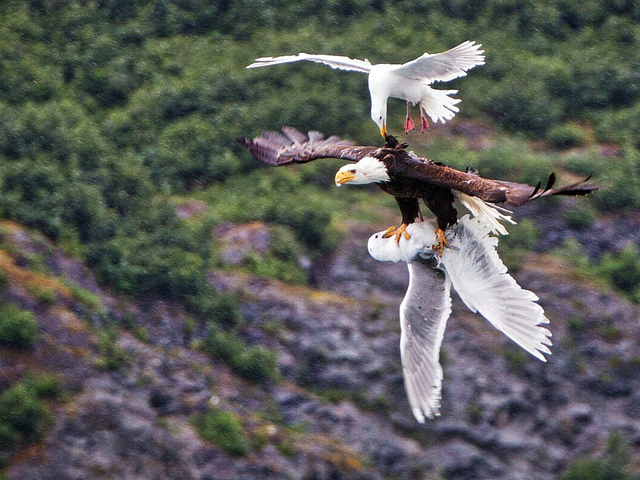
In the thrilling theater of nature, a mesmerizing snapshot unfolds, immortalizing a seagull's valiant attempt to rescue a comrade ensnared by the clutches of a formidable bald eagle. Weighing up to a daunting 17 pounds, these majestic raptors reign as ferocious hunters and voracious eaters of the avian realm.
Yet, amidst this breathtaking encounter, an intriguing tidbit emerges—bald eagle nests, colossal citadels of their skyward kingdoms, can tip the scales at a staggering 2000 pounds. It's a testament to the grandeur and gravity of the natural world, where the drama of survival and sacrifice plays out against the backdrop of untamed wilderness.
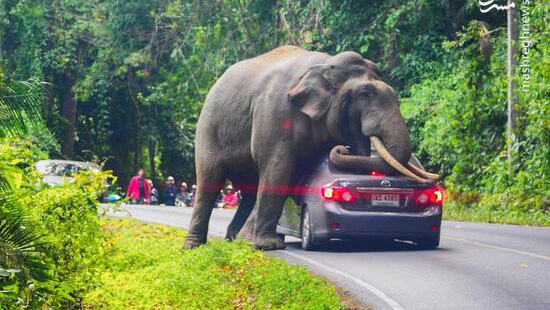
In a surreal moment where the mechanized world met the majestic wilderness, this breathtaking photograph crystallizes an encounter between an automobile and a fully grown elephant.
It's a collision of worlds, highlighting the awe-inspiring coexistence of humanity and nature on our shared planet. This remarkable image serves as a vivid reminder of the delicate balance we must strike between our modern, technological lives and the remarkable wildlife that shares our world. It prompts us to reflect on the responsibility we bear to protect and preserve the remarkable wildlife that inhabits our world. In the face of such encounters, we are reminded that our actions can either disrupt or harmonize with the delicate balance of the natural world, and the choice is ours to make.
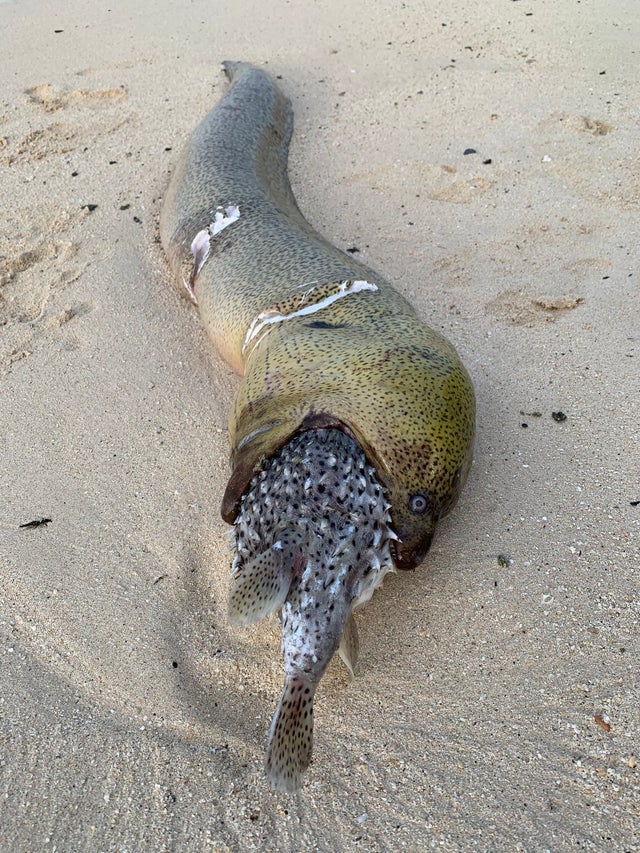
On the sun-kissed shores of the Cook Islands in the Pacific Ocean, a bizarre tableau unfolds—an unfortunate 4-foot moray eel, lifeless and stranded, its fate sealed by an ill-fated encounter with a pufferfish. In a twist of nature's cruel irony, the pufferfish, when cornered, resorts to a desperate defense—a lethal self-inflation.
In this eerie image of a pufferfish skeleton, the stark warning is crystal clear, illustrating the peril these seemingly gentle creatures pose to would-be predators. A haunting reminder that beneath the tranquil surface of the ocean, the dance of life and death continues, unveiling secrets both mesmerizing and macabre.
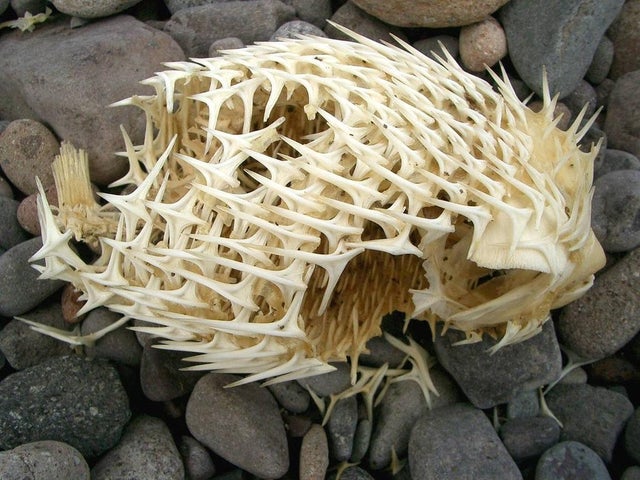
Within the intricacies of the pufferfish lies a mesmerizing defense mechanism—these formidable spines, transformed scales, hold the power to inflate their bodies to two or even three times their usual size, an astonishing feat of nature's engineering. Beneath their beguiling exteriors, most pufferfish harbor a potent neurotoxin, tetrodotoxin, a substance that eclipses cyanide in lethality by a staggering 1200-fold.
In the culinary realm of Japan, these enigmatic creatures become fugu, a tantalizing delicacy. Yet, the art of fugu preparation demands a rigorous apprenticeship of three years or more, a testament to the respect and caution bestowed upon the potent beauty of the pufferfish.
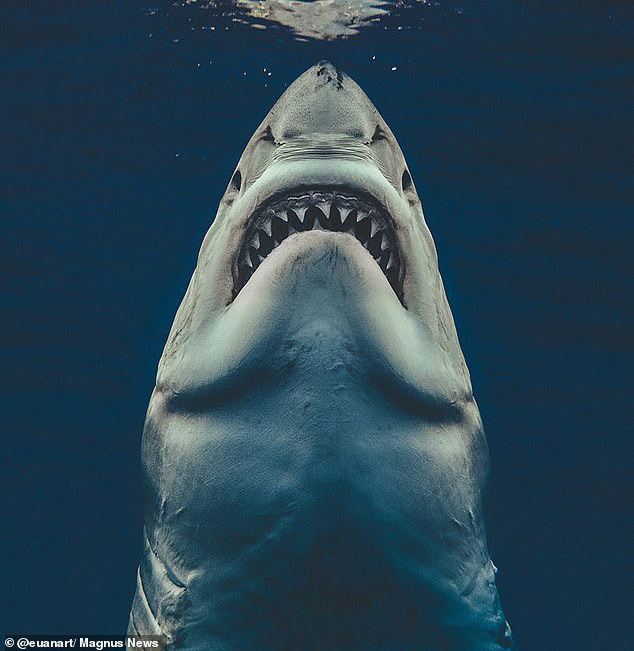
In the azure depths off the western coast of Mexico, a British cage diver finds himself in a real-life homage to Spielberg's iconic 1975 masterpiece. Here, beneath the sun-dappled waters, a colossal 17-foot great white shark emerges, its sinuous form mirroring the chilling poster that once haunted the silver screen.
Yet, unlike the cinematic suspense, there are no hapless swimmers in sight, offering a sigh of relief in the face of primal majesty. It's a moment where reality transcends fiction, a heartbeat in the vast theater of the ocean, where the legacy of a cinematic legend meets the awe-inspiring beauty of nature's apex predator.
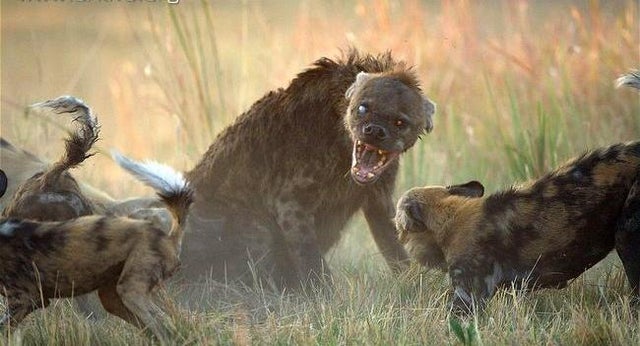
In the heart of the untamed wilderness, this captivating photograph unravels a riveting drama—an intense standoff between a solitary hyena and a relentless pack of wild dogs, a high-stakes moment that could spell a grim fate for the hyena. Remarkably, a study from Duke University unveils the astonishing intellect of hyenas, showcasing their prowess in problem-solving and social collaboration, surpassing even the vaunted chimpanzees.
What sets them apart is the cloak of silence that shrouds their feats, for these clever creatures rely solely on non-verbal cues, an unspoken language that binds them in the intricate tapestry of survival, where every gesture whispers a tale of life and death.
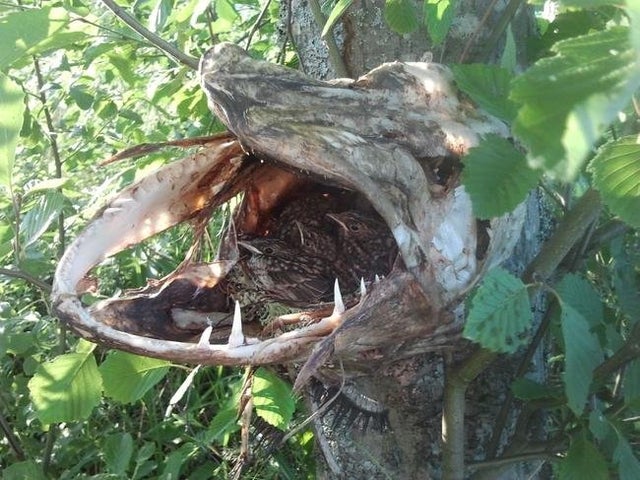
In a surreal fusion of nature's contrasts, this striking image presents a perplexing sight—birds, tenants in the cavernous maw of a pike fish. How did this fish find itself perched in a tree, defying the aquatic realm? Nature's enigma reveals itself, possibly a consequence of flooding or the cunning strategy of a predator.
The arboreal niche proves an unexpected haven, sheltering these avian inhabitants. Even the pike's formidably serrated teeth stand sentinel, offering an unforeseen shield against lurking threats. Amidst the perplexing tapestry of existence, it's a testament to life's adaptability and nature's penchant for crafting the extraordinary from the ordinary.

In the aftermath of a relentless flood, a scene unfolds that defies the relentless force of nature—a colossal shipping container, a symbol of human industry, yielding to the unyielding might of a single tree. Frozen in time, it's a testament to the indomitable strength of nature's architects. The unwavering tree and its intricate root system stand tall, an embodiment of resilience and steadfastness.
In this unequal contest, it's a resounding victory for the arboreal sentinel, a poignant reminder that amidst the chaos and turmoil, the natural world, with its silent fortitude, endures, reminding us of the fragile balance between human endeavors and the ageless majesty of the Earth.
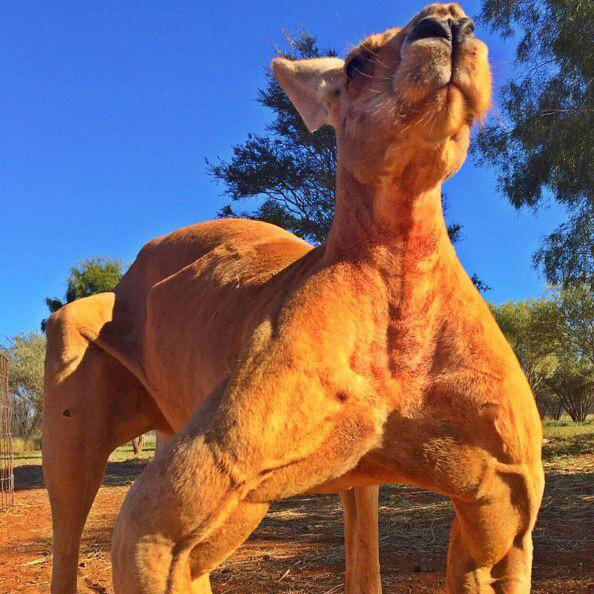
Roger, the enigmatic kangaroo sensation, has indeed left an indelible mark in the annals of wildlife lore. His journey from a frail, sickly joey to a towering 6-foot-7, 200-pound colossus is nothing short of remarkable. It speaks volumes about his indomitable spirit and his sheer will to not only survive but thrive.
Beneath those bulging muscles, however, lies an intriguing facet of Roger's personality – he isn't just a gentle giant. He has earned notoriety for his occasional tussles with the founder of the animal sanctuary he calls home. This unexpected side of Roger's story adds layers to his captivating saga of resilience. It serves as a visual reminder that even in the animal kingdom, unexpected transformations can shape legends that challenge the status quo. Roger's story is not just about physical strength but also about the complexities of the animal kingdom, where strength, personality, and the indomitable spirit converge to create unique and enduring legacies.
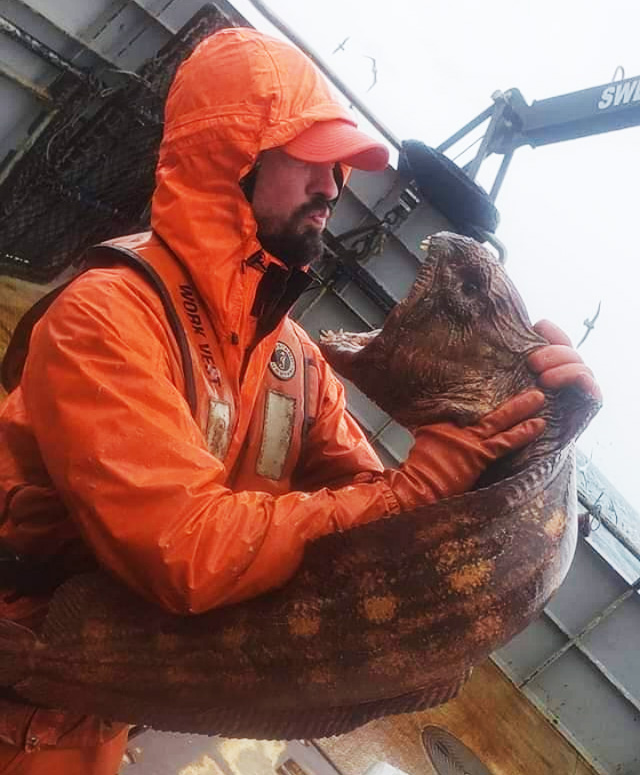
Meet the "wolf eel," a creature that defies expectations and taxonomy. Despite its name, this enigmatic marine dweller isn't an eel at all, but a long, slender fish. The youth of the species showcases a striking red-brick hue, as if painted by nature itself. As they mature, these colors mellow into a palette of grays and browns.
With a potential length of up to eight feet and a staggering 200 spinal vertebrae, adult wolf eels are true marvels of the deep. Found in the North Pacific, they are renowned for their gentle demeanor, unhurried pace, and amiable interactions with divers, dispelling the myth of the fearsome wolf.
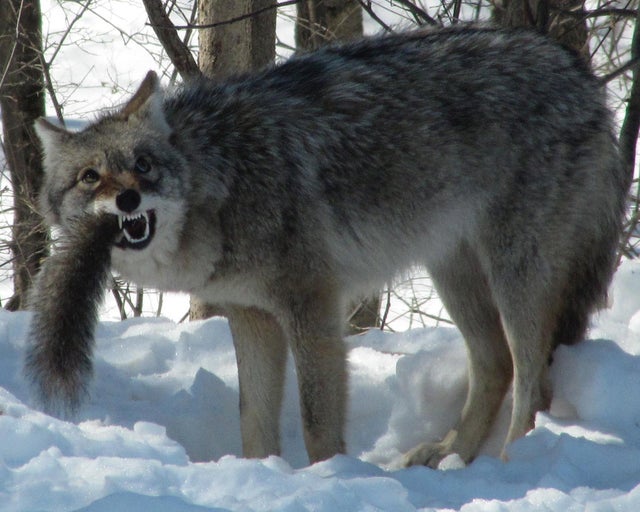
In the urban jungle, the coyote reigns supreme as a stealthy lone predator. While they may form packs for larger game like deer, it's the solo coyote that becomes the nimble squirrel's nemesis. As cities expand, so do urban coyote populations.
In a revealing study by Utah State University, 105 urban areas across America were surveyed in 2016, and a staggering 96 of them were found to be coyote territory. These adaptable canids have seamlessly integrated into our concrete landscapes, showcasing their survival prowess and cunning hunting skills in the heart of the human domain.

In the curious world of genetics, sometimes nature unveils its whimsical side. This chick, a four-legged wonder, defies the conventional norms of poultry. Polymelia, a genetic birth quirk, occasionally graces chickens with extra limbs, rendering them as unique anomalies. Astonishingly, these multi-limbed birds often carry on with life's poultry pursuits undisturbed, as if embracing their eccentricity.
In a feathered twist of fate, they strut through barnyards and coops, a testament to nature's boundless creativity. As they cluck alongside their two-legged comrades, they remind us that in the realm of genetics, the extraordinary can sprout from the ordinary.
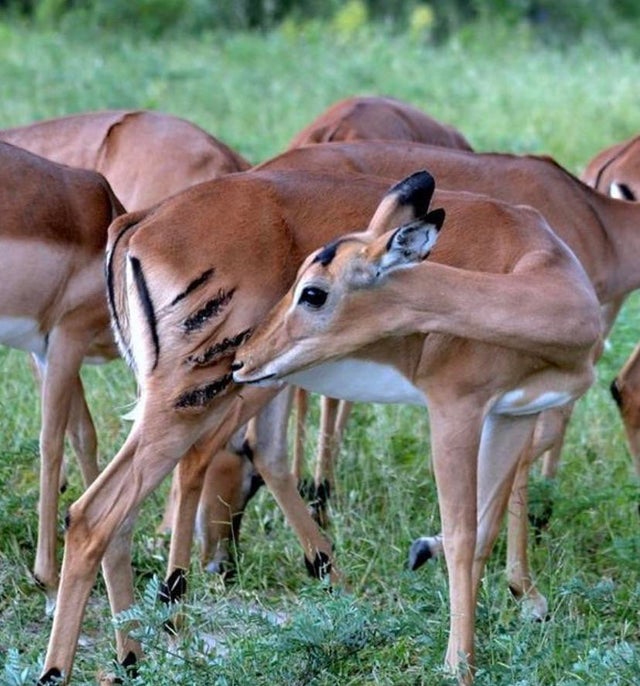
In the unforgiving African wilderness, impalas dance on the edge of survival, navigating a perilous journey into adulthood. Born beneath the merciless sun, their destiny is intertwined with the shadows of predators. A daring theory suggests that these resilient creatures can defy nature's clock, delaying birth to outwit lurking danger.
With the agility of mythical creatures, impalas spring more than three times their stature, weaving a serpentine path to freedom. In this high-stakes game of life and death, the odds are stacked against them, but their nimble grace and strategic maneuvers may tip the scales in their favor, ensuring the survival of the fittest.
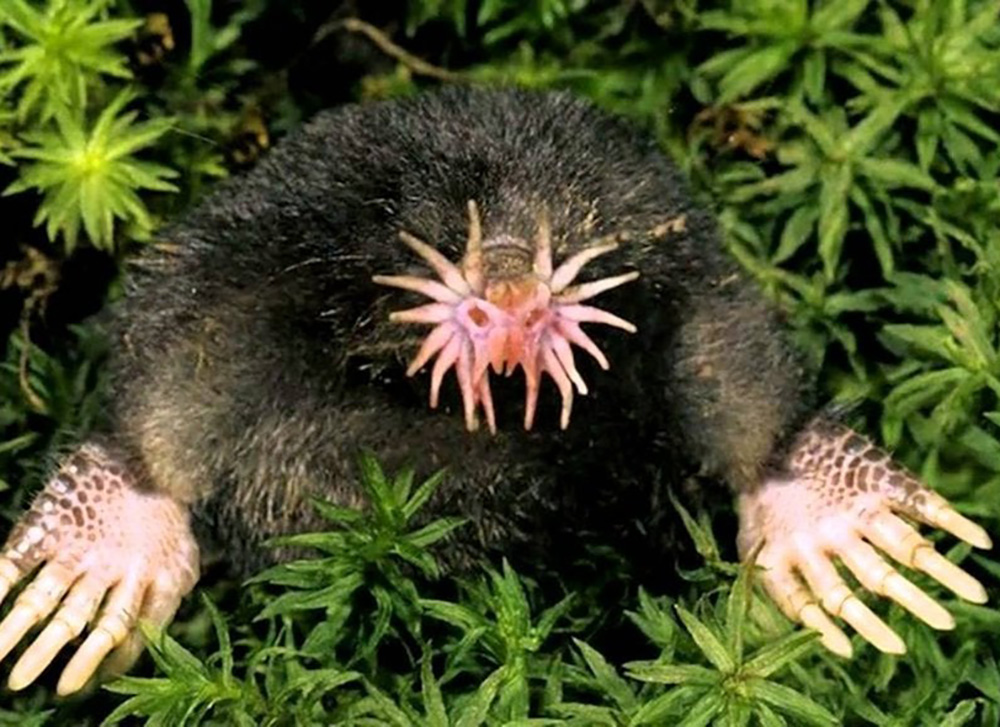
Meet the star-nosed mole, nature's rapid-fire gourmet. With its peculiar star-shaped snout brimming with over 100,000 nerve fibers, this underground marvel is a culinary virtuoso. In the blink of an eye, it deftly discerns the delectable from the inedible, all in under a dizzying quarter of a second.
When it comes to the art of devouring, the star-nosed mole reigns supreme, outpacing every mammal on the planet. With a culinary prowess that defies the ordinary, it's a true gastronomic maestro, demonstrating that in the animal kingdom, the need for speed can lead to some extraordinary adaptations.
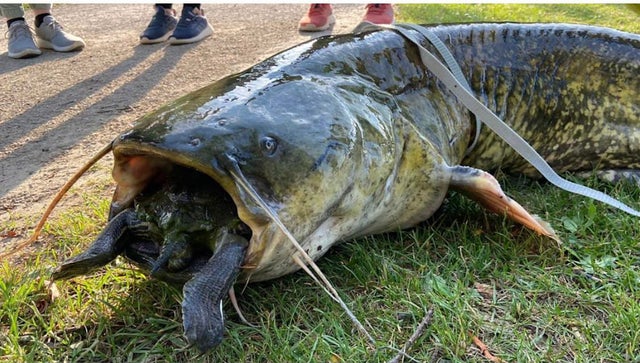
In the watery arena of survival, even the mighty sometimes meet their match. This ill-fated encounter between a voracious catfish and a determined turtle ended in a watery grave for both. The catfish, notorious for its indiscriminate appetite, found itself in a final battle it couldn't conquer.
These aquatic gluttons have been known to fall for quite the peculiar bait, from chunks of Ivory soap to gummy worms, marshmallows to bubblegum, hot dogs to Spam, and even dog food or the sweet allure of mulberries and persimmons. In the ever-unpredictable world below the surface, culinary curiosity can lead to the most unexpected outcomes.
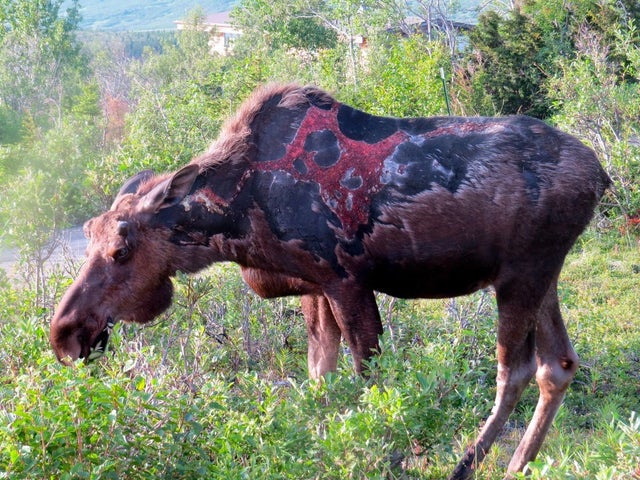
In the untamed wilderness of Glen Alps, Alaska, an astonishing wildlife encounter unfolded before the eyes of a vigilant resident. A massive moose, once presumed to have succumbed to a grizzly's wrath, reappeared against all odds.
Local whispers spoke of a brutal skirmish with a bear, a clash of titans in the animal kingdom. The moose, initially thought to have met its end, made a surprising return, venturing into a neighbor's yard. Nature's resilience, where life can defy even the fiercest adversaries, played out in this remarkable tale of survival, a testament to the enduring spirit of the wild.
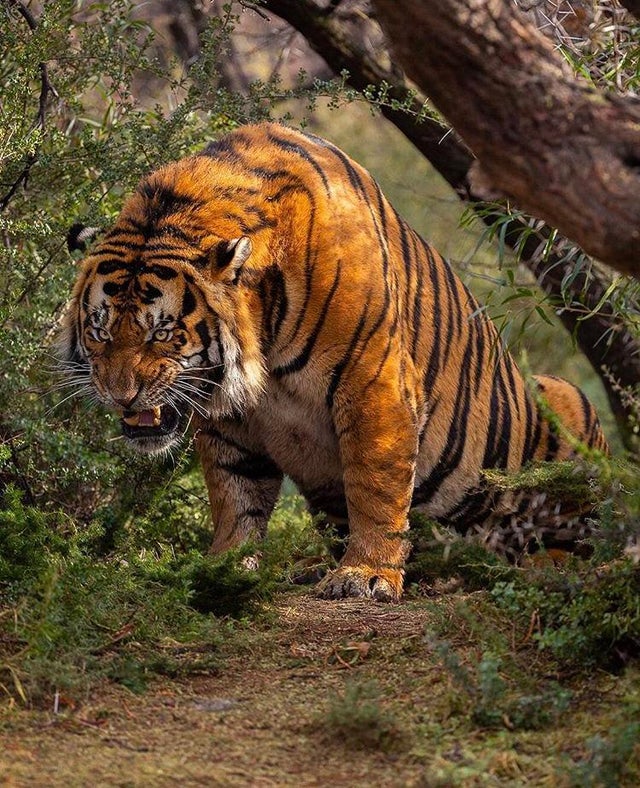
In the world of apex predators, one name stands out as a true titan among tigers: Jaipur. This Siberian behemoth etched his name into the annals of the wild as the largest tiger ever recorded. In the year 1986, Jaipur, a majestic male, measured an awe-inspiring 10 feet and 11 inches from his regal nose to the tip of his formidable tail.
His colossal presence weighed in at a staggering 932 pounds, cementing his status as a veritable giant among his striped brethren. In the grand tapestry of nature, Jaipur's majestic proportions set a benchmark that still leaves jaws dropped and hearts captivated.
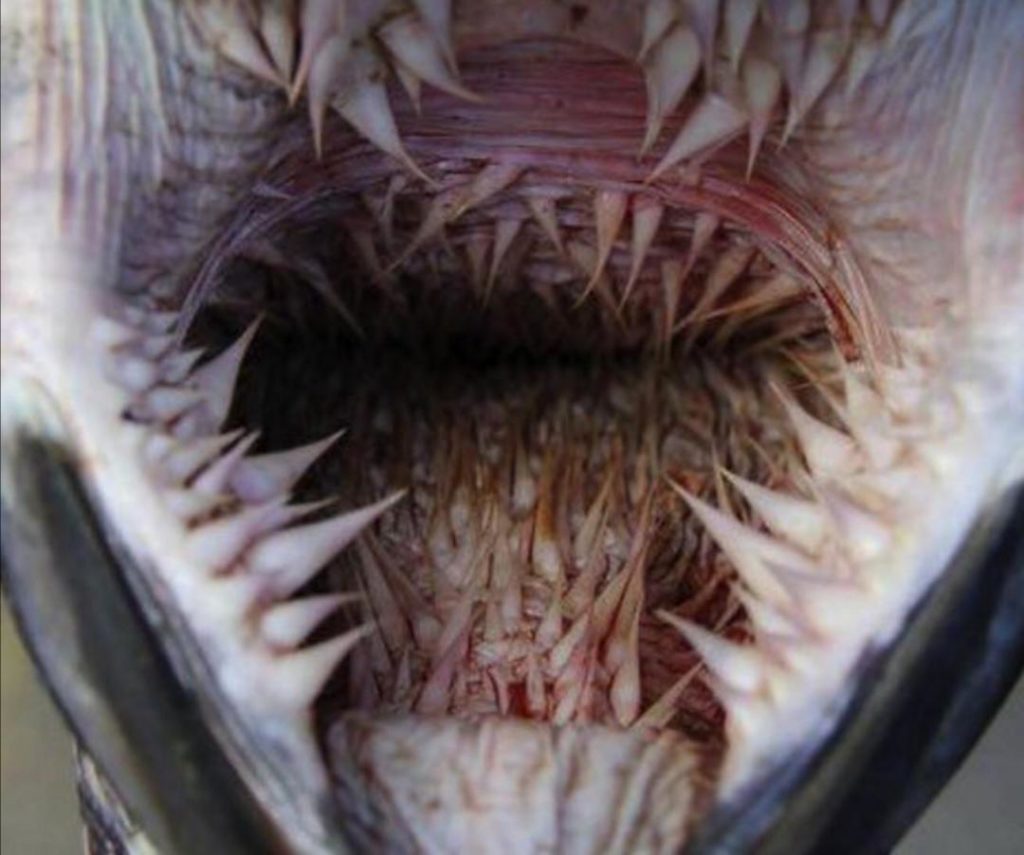
Behold the enigmatic inner sanctum of a sea turtle's mouth – a world of intrigue and adaptation. Papillae, those spiny sentinels, stand sentinel in a tapestry of biological wonder. These curious projections serve as the turtle's trusty gatekeepers, capturing sustenance and preventing it from slipping into the abyss.
Comprising the mouth, esophagus, and the road to the stomach, these structures are crafted from the same protein that graces human hair and nails. Their mission: to orchestrate a reverse filter, sifting sustenance from seawater. But amidst this ecological ballet, the bane of our oceans looms – plastic, often ensnared, a stark reminder of the imperative to preserve these aquatic realms pristine and free from pollution.

Within the imposing citadel of a Harpy eagle's nest, an avian graveyard tells a tale of supreme Amazonian prowess. These colossal eagles, South America's apex aerial predators, lord over the rainforest canopy with wingspans extending up to an awe-inspiring six and a half feet.
Their dominion, the Amazon, echoes with legends of their might as they commandeer the skies. In the macabre remnants of their feasts, we glimpse the avian butchers' conquests – monkeys, sloths, and even deer, all fallen under the talons and beaks of these raptors. The nest's eerie trophies bear witness to nature's relentless cycle of life and death.

Beneath the icy Antarctic waves, the leopard seal, a true oceanic predator, orchestrates its sinister symphony of survival. Its menu primarily features penguins, and with unparalleled ambush tactics, it seizes its feathered victims.
Clamped in its vice-like jaws, the seal's elongated, curved teeth become weapons of destruction, violently rending prey at the water's surface. Penguins, unfortunate souls, meet their demise, transformed into swallowable morsels amidst the watery chaos. Among these formidable creatures, females reign supreme, growing up to a staggering 1,300 pounds, their sleek, 10-foot-long forms epitomizing nature's mastery in the unforgiving Antarctic realm.

Behold the majestic mountain lion, nature's embodiment of power and grace. This awe-inspiring photo captures the essence of their formidable presence. At full maturity, these magnificent beasts can stretch up to a staggering 8 feet from their regal noses to the tips of their sinuous tails, and their robust bodies can bear the weight of up to 175 pounds.
Yet, in the untamed expanses of the wild, it's entirely plausible that even mightier specimens roam, shrouded in mystery. This particular feline, immortalized in the image, seems to defy convention, a silent testament to the untold stories hidden within the rugged landscapes they call home.
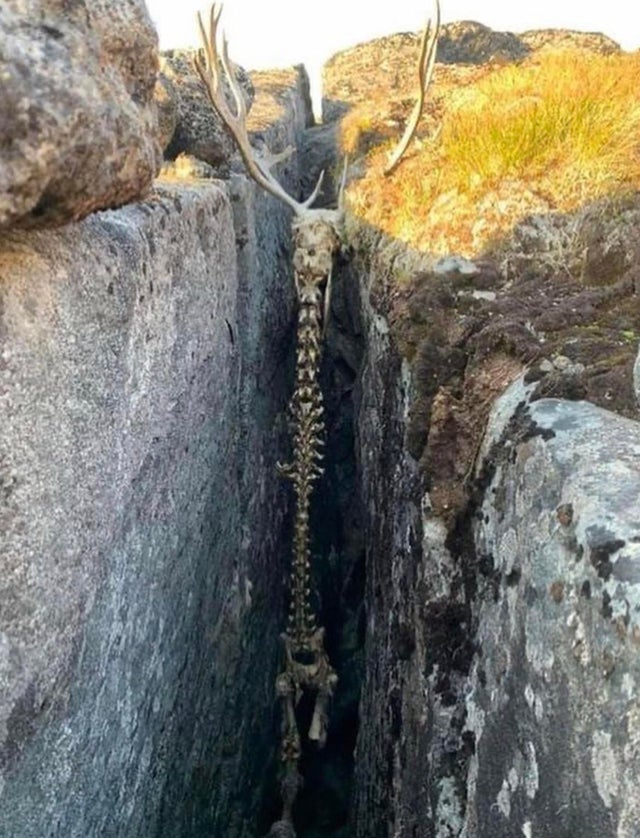
In the unforgiving world of nature, this hapless deer met its untimely demise, trapped in the unyielding embrace of a gaping rock crevice. This poignant image captures a moment frozen in time, where life's struggle against the formidable forces of the wilderness reached a tragic conclusion.
It stands as a stark illustration of the unforgiving challenges that wildlife faces daily. Nature, while awe-inspiring and beautiful, is also marked by its relentless and often harsh realities. The plight of this deer serves as a somber reminder that beneath the serene beauty of the wild lies a world where survival is a constant battle, and where even the most graceful creatures can meet untimely and tragic fates.